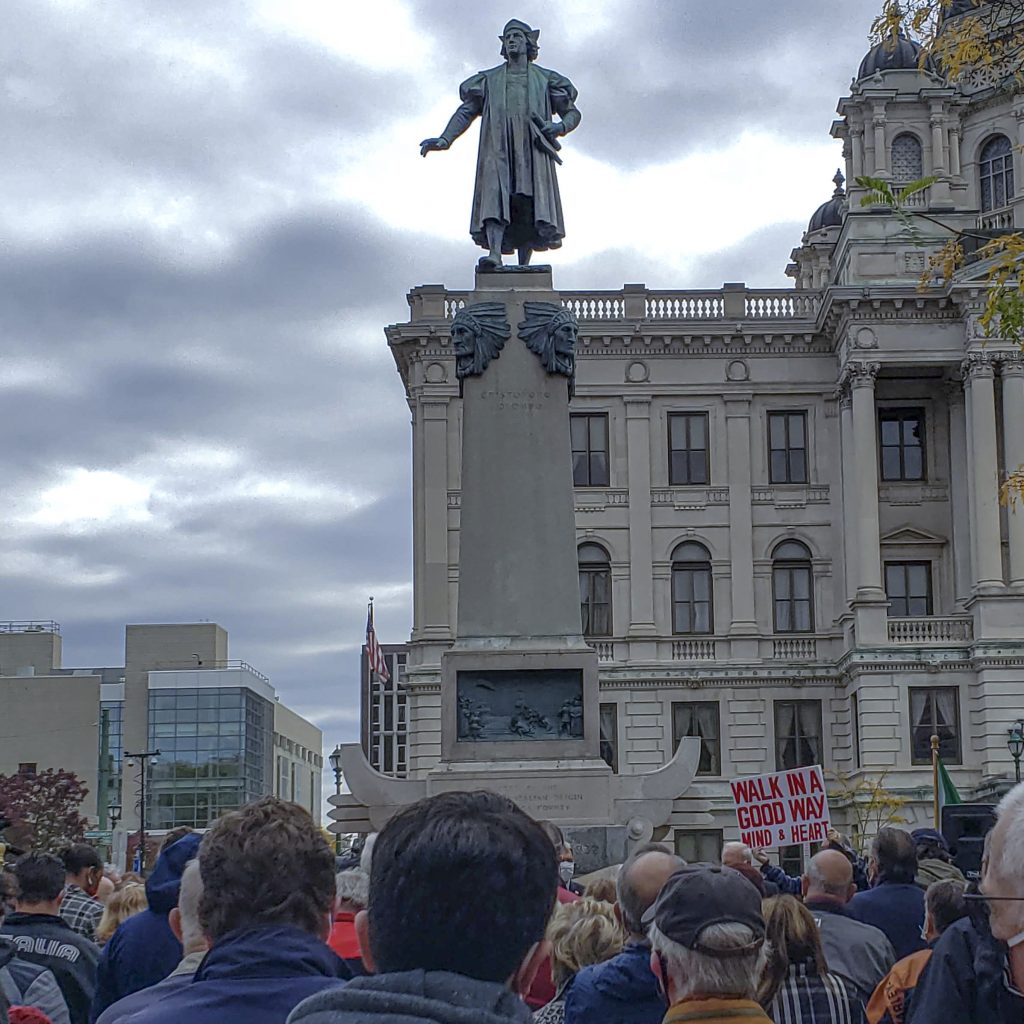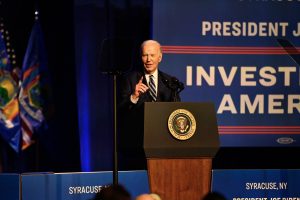Removal of Christopher Columbus statue divides local residents
Removal of Christopher Columbus Statue creates divided debate in the city

Divisive reactions emerged from the Syracuse community after Mayor Ben Walsh’s announced his plan to remove the Christopher Columbus statue and change the name of Columbus Square this past week.
Walsh made the announcement that the Columbus statue would be removed, as well as the heads of Indigenous peoples of the Plains and bas relief plaques that sit below Columbus on the statue, in a press release and subsequent press briefing on Friday, Oct. 9. Walsh also said he will be moving them to private property, but that the fountain and monument at the circle’s center will still remain standing as a permanent memorial to Italian Americans.
“I acknowledge today that I’m causing some pain in this decision. I don’t take that lightly,” Walsh said. “But I do believe in the long term, this will help to heal our community in a way that, again, does honor and respect our Italian-American community and their history, but does it in a way that isn’t divisive.”
Community members and politicians alike came to the gathering on Columbus Day to protest the mayor’s decision.
Community leaders, including House Rep. John Katko, New York State Assemblyman William Magnarelli, County Executive Ryan McMahon and New York State Governor Andrew Cuomo, made statements at the wreath laying ceremony opposing Walsh’s decision to remove the statue.
Syracuse Republican Committee Chairman Randy Potter was appalled by the decision, saying the monument is an integral part of Syracuse’s history. Potter said the monument helps remind people of America’s complicated history.
“Let the historians debate back and forth whether Christopher Columbus was a good guy, but it’s part of our history,” Potter said. “We need to remind people of what has gone on and that our past is not perfect. We need to improve in the future. And this [the monument] is a way to help improve relationships between groups.”
Macsen Rutledge, a community member, echoed similar sentiments, saying, “I think people don’t know the history of the city, and it’s sad. And when you tear down statues and monuments, it’s more historical ignorance.”
But there are Syracuse residents who support the removal and reinstallation news. These residents believe that the depiction of Columbus standing over bodiless heads of Native Americans is subservient and inappropriate. Many said the monument celebrates Columbus too much and fails to acknowledge his problematic history.
Samuel Gruber, a Syracuse University art history professor, said the decision has “given it new life and reinvigorated the whole discussion about the history of the Italian community in Syracuse,” which is something that he said has been ignored previously.
Gruber compared it to curators moving a piece of art in a gallery.
“In a museum when we take a picture that’s been hanging on the same wall next to the same pictures for decades, and we suddenly move it to another room and put it against other pictures, our ideas of that work change altogether,” he said.
Walsh said that the statue will be moved to a private location, but the details of whether it will be accessible to the public have yet to be decided. He said he would like the Italian-American community to prompt that decision.
This isn’t the first disagreement about the Columbus statue and what it symbolizes. It has been the source of much debate since the late ’80s, and in 2017 when Walsh was on the campaign trail, he received many questions of how he planned to address the controversial monument.
The City of Syracuse contracted InterFaith Works in 2018-19 to address the question of what Syracuse should do about Columbus Day. The creation of the Columbus Circle Action Committee was an extension of that previous initiative.
The committee was comprised of 23 total community members representing the Onondaga Nation. This included the Italian-American community, New Americans, communities of color, faith-based organizations, local government leaders and members from the previous InterFaith Works discussion.
Andrea Jacobs, one of the InterFaith Works facilitators, said the committee never intended to come to one, undisputed agreement. Instead, they came up with five scenarios, ranging from keeping the statue and modifying the monument, to completely removing it and redesigning the circle. None of these scenarios gained unanimous support.
Jacobs said the sticking point for the group was the argument of intent versus impact. She said that argument was something the committee frequently came back to, and, in the end, never came to an agreement on.
Rita Paniagua, a committee member and common councilor, said a point of contention for her was if she could blame Columbus for the actions of all European colonizers.
“You can’t blame one person for the activities and the behaviors of 500 years of people,” Paniagua said. “Each of us is our own person, and we have the right and the power to decide what’s wrong and what’s right.”
Moving forward, Walsh does not have a defined plan for when the statue, plaques and Native American heads will be coming down, or what will replace it and how much it will cost.
The plans will need approval from the Public Art Commission by the Syracuse Landmark Preservation Board, as well as review by the State Historic Preservation Office. Walsh said he hopes that the Syracuse and Italian-American community will also play a role in this decision-making.
Jacobs said, based on conversations she had with the mayor, she believes a commission will be formed to look at the recommendations given in the Action Committee’s final report in order to make these decisions.
Kate Elliot Auwaerter, of the Syracuse Land Preservation Board, said that normally, for the city-owned property, the city does not need to submit a certificate of appropriateness for Landmark Board approval. After the monument’s restoration in 1992, however, the city added an additional protection to the fountain and statue that would require the city to submit a certificate of appropriateness for those alterations.
Auwaerter said for possibly controversial alterations the board will invite future applicants — in this case, the city — to come to the board’s regular meetings to have an informal discussion about appropriate alterations. The board can push the applicant in one direction or the other.
She said the board is comprised of both designers and non-designers, preservation professionals, historians and real estate experts.
“There are some well-qualified people who are on the board that I think will be able to tackle these difficult issues,” she said.
She added that they will need to consider difficult issues, such as the value of the Columbus statue and the history of the Columbus Circle.
Jacobs said that for many people removing the statue, it “leaves a hole in public space in the way that they’ve just understood Syracuse and what it is, what it means and what it looks like.”
Walsh said he hopes that “even if they [the community] are feeling upset or hurt right now, they will be willing to reengage at the appropriate time to make sure that we get the next part right, which is what comes after.”





